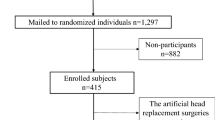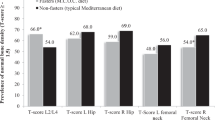Abstract
Objective: To assess the impact of anorexia nervosa and that of nutritional rehabilitation on bone resorption.
Design: Cross-sectional, observational study.
Setting: Rome, Italy
Subjects: Twenty-eight female patients affected by anorexia nervosa (AN, BMI≤17.0 kg/m2), 18 females rehabilitated from anorexia nervosa and weight-stable for at least 6 months (RE, BMI ≥18.5 kg/m2) and 34 age- and sex-matched healthy controls (CO, BMI ≥18.5 kg/m2). Among AN patients, 16 were affected by the ‘restrictive’ (ANr) and 12 by the ‘purging’ type (ANp) of anorexia nervosa.
Methods: Body weight, height and skeletal diameters were measured on each individual. The skeletal mass (SKM) was predicted from the skeletal diameters of the elbow, wrist, knee and ankle, using the equation of Martin. Twenty-four-hour urinary excretion of pyridinium crosslinks of collagen (pyridinoline (Pyd) and deoxypyridinoline (Dpd)) and creatinine was assessed by reversed-phase HPLC with fluorimetric detection after solid-phase extraction and by the Jaffé-method with deproteinization, respectively.
Results: Twenty-four-hour urinary output of Pyd and Dpd was not significantly different between AN and CO when expressed in absolute values, but AN showed higher bone resorption than CO when Pyd and Dpd excretion was adjusted by either creatinine (P<0.0000) or the SKM (P<0.05). Within the AN group, urinary excretion of both cross-links was significantly and consistently higher in ANp compared with ANr (P<0.05). However, these differences disappeared when crosslink output was adjusted either by urinary creatinine or SKM. RE subjects showed no differences in bone resorption with the AN group despite weight gain, being crosslink excretion consistently elevated compared to controls (Pyd: P<0.01 by creatinine and P<0.05 by SKM; Dpd: P<0.01 by creatinine and P<0.05 by SKM).
Conclusion: Bone resorption is elevated in anorexia nervosa and different strategies for low-weight maintenance do not seem to have a differential impact. Increased bone resorption persists in subjects with past diagnosis of anorexia nervosa despite rehabilitation lasting more than 6 months. This finding indicates that bone mass and turnover should be monitored in anorexia nervosa patients and ex-patients well beyond recovery of normal body mass. Further investigation is warranted to examine the long-term effect of such prolonged increase in bone turnover at a young age.
Sponsorship: Dr. Valtueña is supported by a Marie Curie Fellowship from the European Commission (Contact no. HPMF-CT-1999-00192).
This is a preview of subscription content, access via your institution
Access options
Subscribe to this journal
Receive 12 print issues and online access
$259.00 per year
only $21.58 per issue
Buy this article
- Purchase on Springer Link
- Instant access to full article PDF
Prices may be subject to local taxes which are calculated during checkout
Similar content being viewed by others
Notes
Whole body-DXA scans (model Hologic, QDR-4500W, Lincoln St. Walthman, Mass) were performed according to a previously published procedure (Fabbri et al, 1999)
References
American Psychiatric Association (1994). Diagnostic and Statistical Manual of Mental Disorders, 4th edn. Washington, DC
Andersen, AE, Woodward, PJ & LaFrance, N (1995). Bone mineral density of eating disorder subgroups. Int. J. Eat. Disord., 18, 335–342.
Bachrach, LK, Guido, D, Katzman, D, Litt, IF & Marcus, R (1990). Decreased bone density in adolescent girls with anorexia nervosa. Pediatrics, 86, 440–447.
Baker, D, Roberts, R & Towell, T (2000). Factors predictive of bone mineral density in eating-disordered women: a longitudinal study. Int. J. Eat. Disord, 27, 29–35.
Branca, F, Valtueña, S, Golden, M & Robins, S (2002). Urinary collagen cross-links as biochemical markers of growth: an evaluation of biological variables. Ann. Nutr. Metab., 46, 80–87.
Caillot-Augusseau, A, Lafage-Proust, MH, Margaillan, P, Vergely, N, Faure, S, Paillet, S, Lang, F, Alexandre, C & Estour, B (2000). Weight gain reverses bone turnover and restores circadian variation of bone resorption in anorexic patients. Clin. Endocrinol. (Oxf.), 52, 113–121.
Castro, J, Lazaro, L, Pons, F, Halperin, I & Toro, J (2000). Predictors of bone mineral density reduction in adolescents with anorexia nervosa. J. Am. Acad. Child Adolesc. Psychiatr., 39, 1365–1370.
de la Piedra, C, Calero, JA, Traba, ML, Asensio, MD, Argente, J & Muñoz, MT (1999). Urinary alpha and beta C-telopeptides of collagen I: clinical implications in bone remodeling in patients with anorexia nervosa. Osteoporos. Int., 10, 480–486.
Fincato, G, Barticci, F, Rigoldi, M, Abbiati, G, Colombo, M, Bartolini, O, Brandi, M & De Leonardis, V (1993). Urinary excretion of pyridiniline and deoxypyridinoline: circadian rhythm in healthy premenopausal women. J. Interdiscpl. Cycle Res., 24, 72–78.
Garnero, P, Hausherr, E, Chapuy, M, Marcelli, C, Grandjean, H, Muller, C, Cormier, C, Breart, G, Meunier, P & Delmas, P (1996a). Markers of bone resorption predict hip fracture in elderly women: The EPIDOS prospective study. J. Bone Miner. Res., 11, 1531–1538.
Garnero, P, Sornay-Rendu, E, Chapuy, M & Delmas, P (1996b). Increased bone turnover in late postmenopausal women is a major determinant of osteoporosis. J. Bone Miner. Res., 11, 337–349.
Garnero, P, SornayRendu, E, Duboeuf, F & Delmas, P (1999). Markers of bone turnover predict postmenopausal forearm bone loss over 4 y: the OFELY study. J. Bone Miner. Res., 14, 1614–1621.
Goldhaber, P & Rabadjija, L (1987). H+ stimulation of cell-mediated bone resorption in tissue culture. Am. J. Physiol., 253, E90–98.
Hotta, M, Fukuda, I, Sato, K, Hizuka, N, Shibasaki, T & Takano, K (2000). The relationship between bone turnover and body weight, serum insuline-like growth factor (IGF) I, and serum IGF-binding protein levels in patients with anorexia nervosa. J. Clin. Endocrinol. Metab., 85, 200–206.
Jagielska, G, Wolańczky, T, Komender, J, Tomaszewicz-Libudzic, C, Przedlacki, J & Ostrowski, K (2001). Bone mineral content and bone mineral density in adolescent girls with anorexia nervosa-a longitudinal study. Acta Phychiatr. Scand., 104, 131–137.
Kehayias, JJ & Valtueña, S (1999). Neutron activation analysis determination of body composition. Curr. Opin. Clin. Nutr. Metab. Care, 2, 453–463.
Lennkh, C, de Zwaan, M, Bailer, U, Strnad, A, Nagy, C, el-Giamal, N, Wiesnagrotzki, S, Vytiska, E, Huber, J & Kasper, S (1999). Osteopenia in anorexia nervosa: specific mechanisms of bone loss. J. Psychiatr. Res., 33, 349–356.
Lohman, TC, Roche, AF & Martorell, R (1988). Antropometric Standardization Reference Manual, Chicago, IL: Human Kinetics
Lucas, AR, Melton, LJ, Crowson, CS & O'Fallon, WM (1999). Long-term fracture risk among women with anorexia nervosa: a population-based cohort study. Mayo Clin. Proc., 74, 972–977.
Marowska, J, Kobylinska, M, Ukaszkiewicz, J, Taajko, A, Rymkiewicz-Kluczynska, B & Lorenc, R (1996). Pyridinium crosslinks of collagen as a marker of bone resorption rates in children and adolescents: normal values and clinical application. Bone, 19, 669–677.
Martin, AD (1991). Antropometric assessment of bone mineral. In:Antropometric Assessment of Nutritional Status, ed. JH Himes, pp184–196, Minneapolis, MN: Wiley-Liss
McLaren, A, Isdale, A, Whitings, P, Bird, H & Robins, S (1993). Physiological variations in the urinary excretion of pyridinium crosslinks of collagen. Br. J. Rheumatol., 32, 307–312.
Polito, A, Cuzzolaro, M, Raguzzini, A, Censi, L & Ferro-Luzzi, A (1998). Body composition changes in anorexia nervosa. Eur. J. Clin. Nutr., 52, 655–662.
Polito, A, Fabbri, A, Ferro-Luzzi, A, Cuzzolaro, M, Censi, L, Ciarapica, D, Fabbrini, E & Giannini, D (2000). Basal metabolic rate in anorexia nervosa: relation to body composition and leptin concentrations. Am. J. Clin. Nutr., 71, 1495–1502.
Pratt, DA, Daniloff, Y, Duncan, A & Robins, SP (1992). Automated analysis of the pyridinium crosslinks of collagen in tissue and urine using solid-phase extraction and reversed-phase high-performance liquid chromatography. Anal. Biochem., 207, 168–175.
Rauch, F, Rauch, R, Woitge, H, Seibel, M & Schonau, E (1996). Urinary immunoreactive deoxypyridinoline in children and adolescents: variations with age, sex and growth velocity. Scand. J. Clin. Lab. Invest., 56, 715–719.
Rigotti, NA, Nussbaum, SR, Herzog, DB & Neer, RM (1984). Osteoporosis in women with anorexia nervosa. New Engl. J. Med., 311, 1601–1606.
Soyka, LA, Grinspoon, S, Levitsky, LL, Herzog, DB & Klibanski, A (1999). The effects of anorexia nervosa on bone metabolism in female adolescents. J. Clin. Endocrinol. Metab., 84, 4489–4496.
Spierto, FW, MacNeil, ML & Burtis, CA (1979). The effect of temperature and wavelength on the measurement of creatinine with the Jaffè procedure. Clin. Biochem., 12, 18–21.
Stefanis, N, Mackintosh, C, Abraha, HD, Treasure, J & Moniz, C (1998). Dissociation of bone turnover in anorexia nervosa. Ann. Clin. Biochem., 35, 709–716.
Valla, A, Groenning, IL, Syversen, U & Hoeiseth, A (2000). Anorexia nervosa: slow regain of bone mass. Osteoporos. Int., 11, 141–145.
Valtueña, S, Sette, S & Branca, F (2001). Influence of Mediterranean diet and Mediterranean lifestyle on calcium and bone metabolism. Int. J. Vit. Nutr. Res., 71, 189–202.
Vesper, HW, Demers, LM, Eastell, R, Garnero, P, Kleerekoper, M, Robins, SP, Srivastava, AK, Warnick, GR, Watts, NB & Myers, GL (2002). Assessment and recommendation on factors contributing to variability of preanalytical urinary pyridinoline and deoxypyridinoline. Clin. Chem., 48, 220–235.
Wachman, A & Bernstein, DS (1968). Diet and osteoporosis. Lancet, 1, 958–959.
Ward, A, Brown, N & Treasure, J (1997). Persistent osteopenia after recovery from anorexia nervosa. Int. J. Eat. Disord., 22, 71–75.
Zipfel, S, Seibel, MJ, Löwe, B, Beumont, PJ, Kasperk, C & Herzog, W (2001). Osteoporosis in eating disorders: a follow-up study of patients with anorexia and bulimia nervosa. J. Clin. Endocrinol. Metab., 86, 5227–5233.
Acknowledgements
We would like to thank Donatella Ciarapica for her help in performing the 24 h urine collections, subject recruitment and anthropometric measurements.
Author information
Authors and Affiliations
Corresponding author
Rights and permissions
About this article
Cite this article
Valtueña, S., Di Mattei, V., Rossi, L. et al. Bone resorption in anorexia nervosa and rehabilitated patients. Eur J Clin Nutr 57, 260–265 (2003). https://doi.org/10.1038/sj.ejcn.1601527
Received:
Revised:
Accepted:
Published:
Issue Date:
DOI: https://doi.org/10.1038/sj.ejcn.1601527
Keywords
This article is cited by
-
Assessment and clinical management of bone disease in adults with eating disorders: a review
Journal of Eating Disorders (2017)



